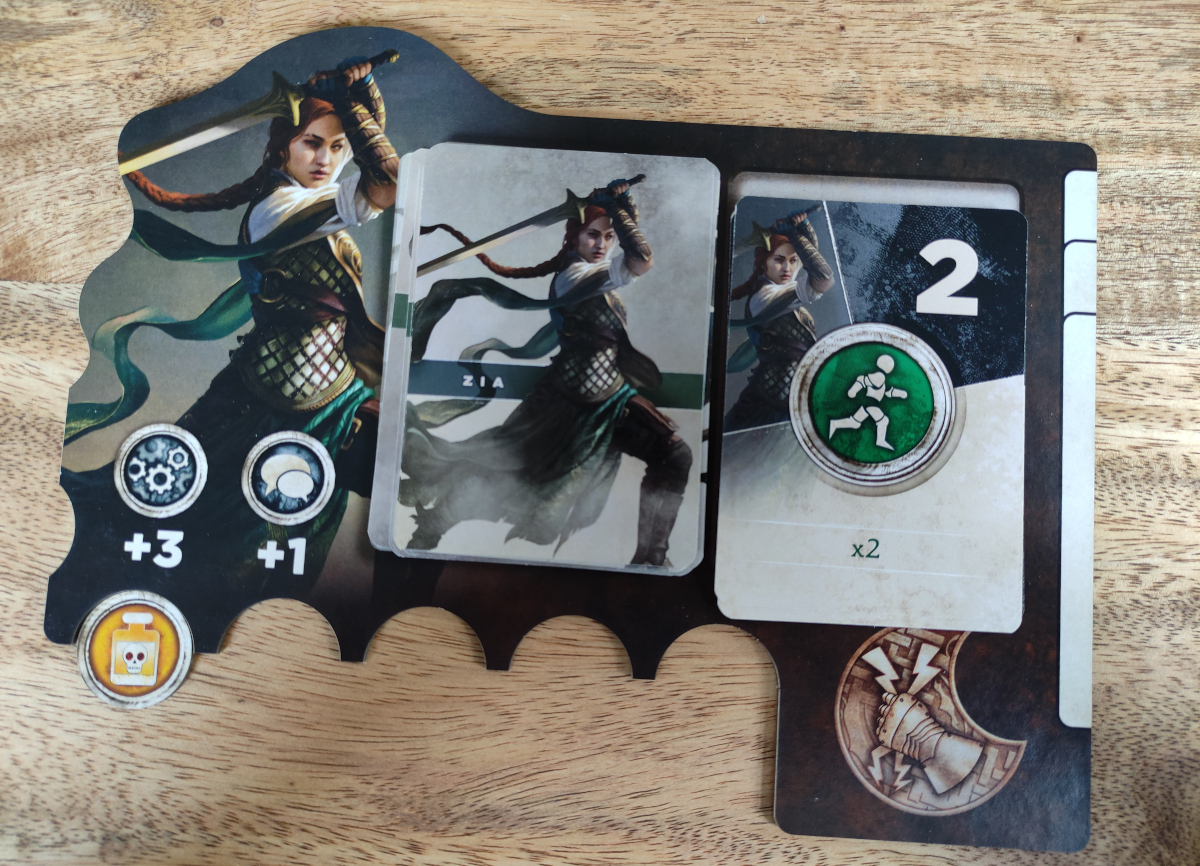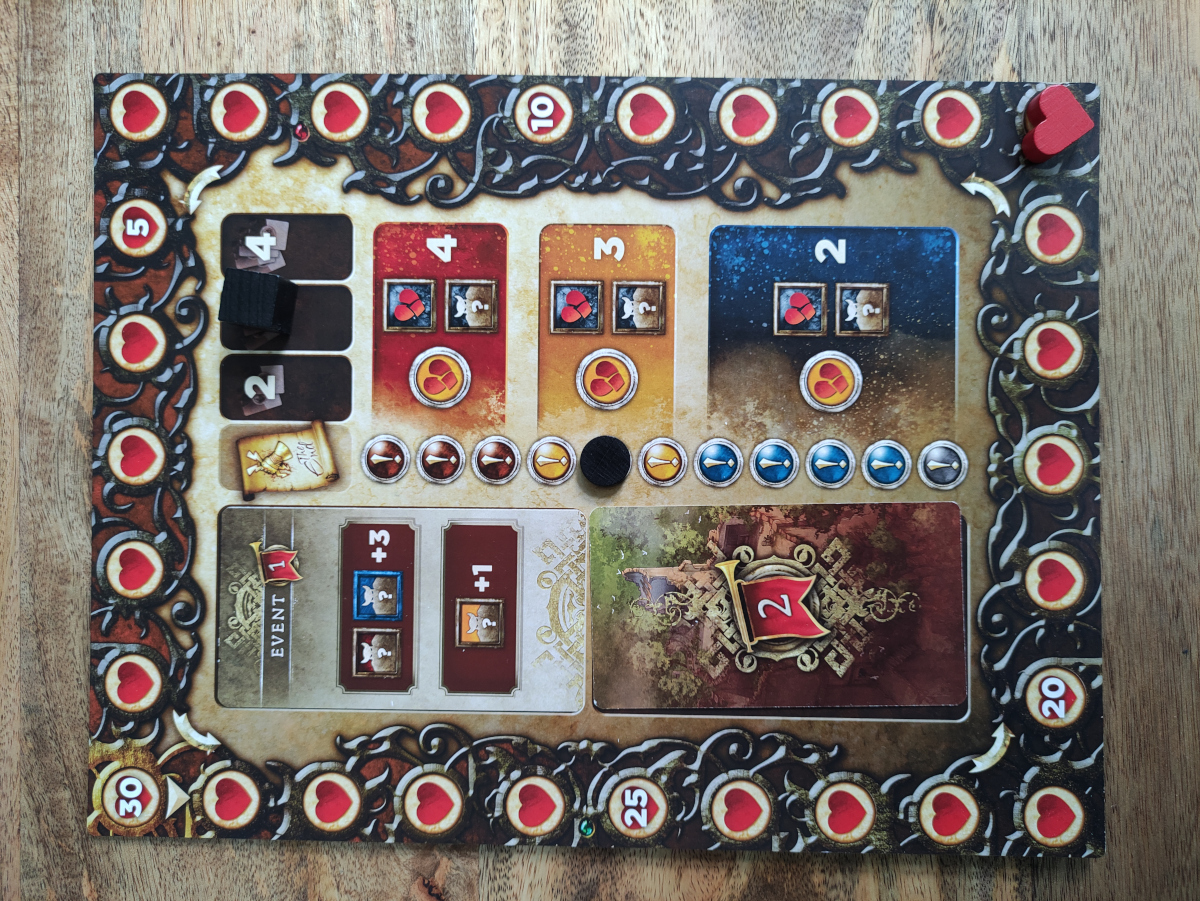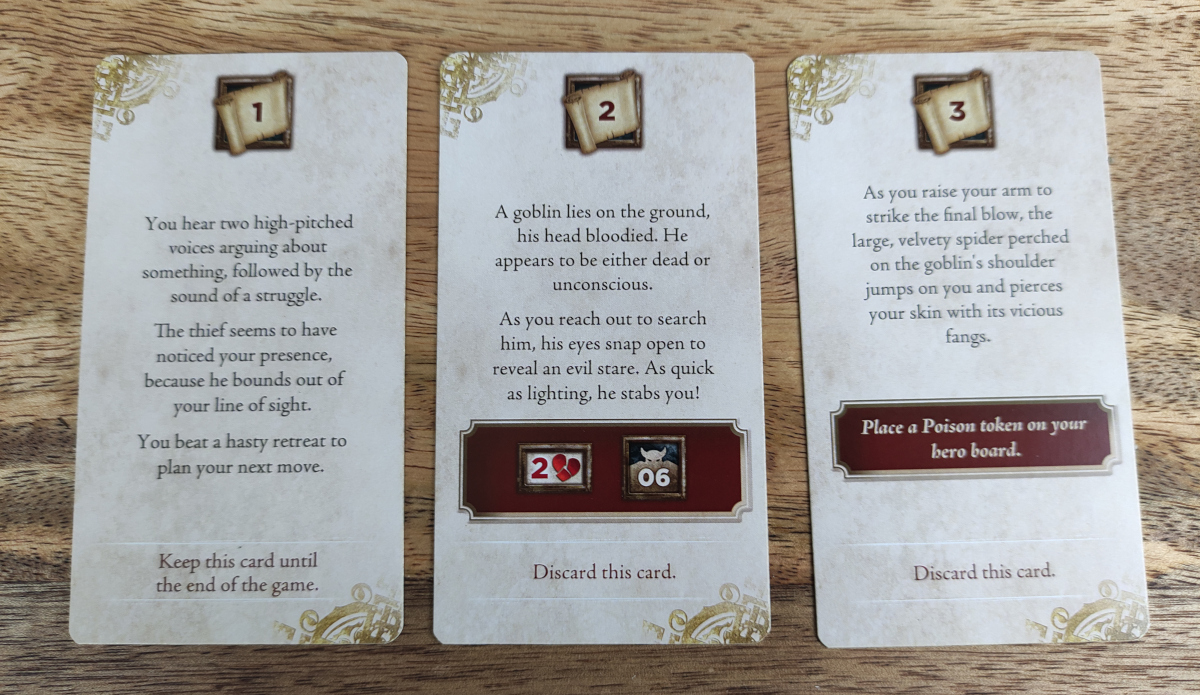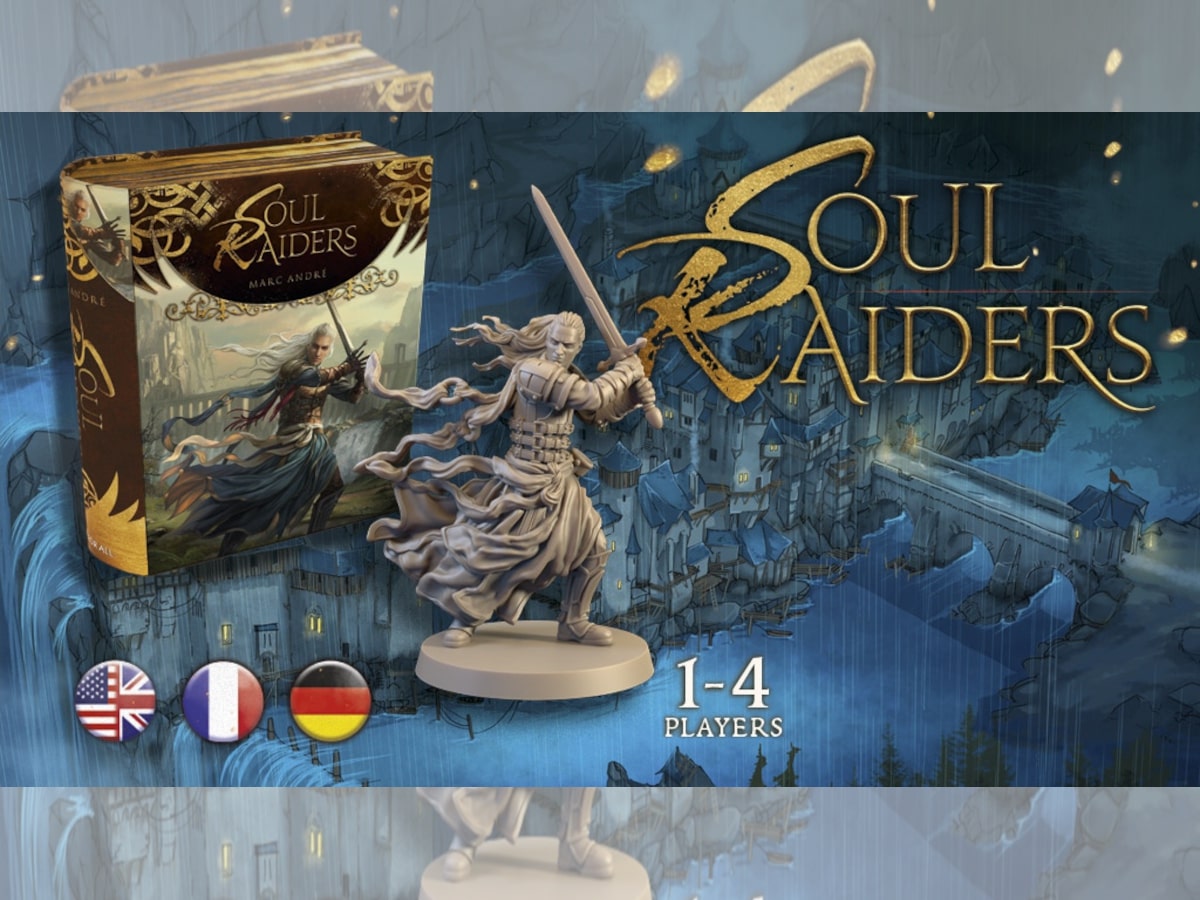Soul Raiders is a cooperative story-driven game in a fantasy setting for 1-4 people. Card-based with an escalating threat system, Soul Raiders is looking for funding on Kickstarter now.
New to Kickstarter? Check out our crowdfunding primer.
What is Soul Raiders?
Soulraiders is a dungeon-crawler without dice that doesn’t always take place in a dungeon. It has a procedurally driven story engine for telling an RPG-like narrative. The mechanics of the game are card and icon-driven, with cards being dealt at certain times and the effects and features of those cards triggered depending on which icons are in play.
There are two pledge levels. The Standard Edition at €70 (83USD) or the Grimoire Edition at €110 ($130 USD). US buyers can expect to add about $20 in postage to that cost. The most significant difference between the two versions is that the Standard Edition does not include any miniatures or deck boxes.
Check out the campaign in detail.
What’s in the Soul Raiders Box?
The exact component list hadn’t been finalized at the time of writing, but here is a broad overview of what you can expect. All photographs included in this review are of prototype components and will be different in the final version.
For Each Hero (Of Which There Are 4)
- 3 Miniatures/Standees. The game has a neat visible/invisible mechanic and these are represented by a standard mini and one made from transparent resin. The finished game also has clones, which didn’t feature in my prototype edition.
- 1 Hero Board.
- 24 Action Cards. Your hand of action cards drawn from these action cards will determine what you can do on a given turn.
- 12 Heroic Actions. As you progress through the game your character can learn new heroic actions, which are then added to your hero deck. They are in essence, a way of “leveling up.”
The standees in my prototype give some idea of what the visible and invisible heroes will look like.
General Components
There are a number of components that are used across each chapter and to run the mechanics of the game.
- The game board. This allows you to keep track of the threat, characters vitae (health), and exhaustion. It also has spaces for two “event cards,” that will be given by the chapter you are participating in. Flipping these story cards during the game means that characters are progressing on their quest.
- 1 X each Threat marker, Vitae marker, and Exhaustion marker (to place on the tracks on the board, outlined above).
- 41 random monster cards. These are drawn when you encounter monsters.
- There are also various tokens that help you keep track of in-game mechanics like poison, fear, and heroism.
Chapter-Specific Components
The base Kickstarter pledge will give you access to 3 chapters. Each chapter has its own locations and special cards. Each chapter contains:
- 42 Location sheets. These are large-format cards (roughly A5 size) that have drawing of a location on.
- Up to 100 story cards. Arriving at some locations or performing certain actions at particular locations enables players to turn over story cards. These cards further the story and can make both good and bad things happen.
- Up to 59 scripted enemy cards. We don’t always meet random monsters in this game. Some events trigger the arrival of specific monsters. You’ll find them in the relevant deck of scripted enemies.
- 2 Event cards. These are major occurrences within the story. These cards sit on the game board and when revealed mark great progress through the chapter.
- 1 Artifact token. The loot! It’s what adventuring is about.
How to Play Soul Raiders
The review copy I was sent contained a standalone Chapter 0. This was to avoid spoiling the story elements of the main game. It also had a slightly cut-down ruleset.
There is an almost overwhelming number of icons in the game. When you start reading the manual it’s a little bewildering, but once you get going the system is intuitive. Once I’d formed an initial understanding of how the Soul Raiders worked, I found it easier to dive in and unravel the mysteries of the icons as I went along.
This is a basic overview of how Soul Raiders works.
The Turn
Each turn of the game comes in three phases.
- Preparation Phase. Temporary spells are discarded. Players redraw action cards.
- Action Phase. Heroes carry out as many actions as they have action cards for. Players can take their actions in any order and can swap between players as the round progresses. There is no need to wait for other players to complete their actions before you commence your own, but coordination of strategy and being aware of what your fellow players are doing is imperative for the success of the game. Usually, players can’t combine action cards to succeed at actions, but in special group activities, it is possible to do so. There are four types of action:
- Movement.
- Scripted Action. (Usually taking an action given on a location card.)
- Combat.
- Spell.
- Reaction phase.
- Stress is calculated. Characters lose as much vitae, as proscribed by the current threat level. If characters have any fear, poison, or fracture tokens they also lose vitae.
- Enemies attack. (Possibly/probably resulting in a further reduction of vitae.)
- Location reactions are resolved. Often the arrival of new wandering monsters.

Heroes
The heroes system in the game is simple. There isn’t too much to track. One important design choice is that heroes don’t have individual tracks for health or exhaustion. This is done on the main gameboard, and there is one track that affects all characters equally. Live as one, die as one!
Each hero has their own deck of cards and a board on which to stack them and discard pile. Each hero also has two bonus icons, which enable them to influence certain types of tests in the game. There is also a nifty section for adding penalty tokens, such as poison, and a place to put all those heroism tokens. Heroism tokens can be spent for extra actions in-game or earning new heroic action cards.
Everything a hero does is governed by their action cards. At the start of the game, they may draw 4 action cards per turn. This will be reduced as the exhaustion score goes up and the characters become more tired.
Action cards all have the same basic function. They each have a value on the top right that can be used to perform any task. Moving, fighting, and searching all have scores that are required to be beaten by a character’s action cards in order to be carried out. You can combine multiple cards to perform single actions. If scrambling up a ruined staircase requires a movement value of 7 you could combine cards that were value 4 and 3 to do so. You only have 4 cards to use, however, so using multiple cards means you can make fewer individual actions overall.

Fortunately, each action card also has a particular flavor, whether that be movement, combat, or magic. These cards have bonuses to the basic card score, so a score 5 card with a +2 move icon could be used in combat to score five, but if moving would allow you to scramble up that staircase in a single card (as it would total 7). The modifiers aren’t always straight “+s” either. Some have +X for the number of action cards you are using or +X for the number of enemies you are facing. This means card choice is often significant.
Spell cards often have one-off effects, but they also allow you to turn invisible, which makes it much easier to move about the location cards unseen.
Key Concepts
In Soul Raiders, characters are trying to achieve chapter goals. The number of goals that need to be met is dependent on the number of players. All games have to complete one primary goal, and the more players you have the more secondary goals players have to complete alongside the primary goal. Goals are marked by colored stars, and when you find (and are instructed to keep) a card with the relevant color star on it, you are considered to have achieved a goal.

Soul Raiders works via two escalation mechanics. The first is Vitae or health. As bad things happen to characters they concede vitae points. This is tracked on the outside of the board. Starting at 30 and counting down to zero. The first time it reaches zero, the first exhaustion level kicks in. This means players only redraw 3 action cards when they reset their hands. Vitae continues going around the track, back to 30, and then downwards towards 0. After reaching 0 a second time, exhaustion goes up again and players may now only draw 2 cards when they reset. If Vitae reaches 0 a third time, the game is over.
Meanwhile, the threat is increasing. The threat track is also traversed on the game board across 4 levels. Events within the game increase the threat and the level of threat present at the end of the players’ turn can mean more wandering monsters turn up and that the party takes additional vitae damage. If the threat escalates beyond level 4, the game is over.
These two mechanics work together against the characters. The higher the threat, the quicker the monsters come and the faster you lose vitae, meaning you end up exhausted faster which means fewer actions, meaning you struggle more and more to defeat the threat. In Soul Raiders game management is a very vicious circle!

Location, Location, Location
Heroes need locations to explore. Each chapter comes with 42 different locations. They’re formed by a double-sided sheet of card, roughly A5 in size with full art of the location drawn on.
Cards are double-sided because different things might happen on the second and subsequent times you reach a location to what happened the first time characters visited. Each location has a location number, given in the top left as well as its name. Below the number of the location is a string of red icons that tells you what players encounter the first time a character enters a location.
These icons are things like:
- Increasing threat.
- Discovering random monsters.
- Discovering a story-specific monster.
- Characters have been ambushed
- Characters lose vitae on entry.

Each location has at least one exit, usually given by an arrow and a number. This is the number of action points players must spend to move their hero to that location. Location cards are kept concealed until put into play, so players shouldn’t know what to expect if they flee blindly from one location to another. Note: Some arrows indicate that any monsters in play will follow the characters into whatever new location they end up in.
There may also be some location-specific tasks on a location card. These usually require a number of action points to overcome, but doing so will most likely drive the story on to new discoveries.
On the bottom left corner, there are orange icons that denote what happens in the Reaction phase. Probably enemies arriving, random or scripted, possibly alarms being set off or maybe the location will be flipped to its alternative (B) side.
The B Side
If all characters leave a location and return it will flip to its B side—unless it is locked (has a lock icon on it), in which case it stays on the A side until otherwise instructed. More fun is when you have to fulfill some actions to get the card to flip because in this instance you’re driving on the chapter’s narrative.
B sides behave in much the same way as A sides. Again, everything is driven by icons. New monsters may appear, new exits might be revealed (you found a secret passageway) or blocked (you caused a tunnel collapse), and there will be additional icons at the bottom of the cards to resolve during the reaction phase.

Why Play Soul Raiders?
If you’re looking for a coop game experience that’s like an RPG but without needing a GM, then Soul Raiders looks to be a great bet. I really like that there are so few miniatures (and a pledge level that means you don’t have to have any). Having models only for the heroes makes those minis feel more special, especially with the additional invisi-mini too. Admittedly, the invisible form is something of a gimmick. You may have noticed turning invisible barely featured in my overview. It’s a neat mechanic, but it doesn’t last that long nor impacts the game hugely. Or at least it didn’t in the proto-chapter we played.
Having so few minis means that you’re not overwhelmed by the volume of the game, nor the price. Too many games these days are swamped by superfluous plastic.
I very much enjoyed the mechanics of this game. There are a lot of icons, which can be overwhelming, especially when you’re trying to learn what they all do. Nevertheless, it is possible to pick the system up as you go, and the game is forgiving of small mistakes. You can usually tell when you’ve made a mistake. If things have suddenly become too easy or too hard, you’ve messed something up.

That said, the escalation of difficulty in the trial scenario was immense. We were traveling along nicely, but once we gained our first exhaustion point and lost an action card per turn, things went against us very quickly. I think the point of this scenario was a “race against the clock” theme, meaning that we were quickly overwhelmed when things started to go wrong. It did feel like it was an impossible task to get close to completing the game, but, in actual fact, it turned out we were only one card draw away from victory. So don’t despair, victory may be closer than you think!
I would expect the story elements to be stronger in the full chapters. Hopefully with less emphasis on overwhelming hordes of enemies. This was fun to play, but I’d hope the full game chapters have more nuance and variety.
The story elements in the trial game were fun. It wasn’t a particularly involved plotline, but it was easy to see how the layers of the story are built with the various story-specific event cards and monsters. There was a definite frisson of excitement when told to draw a specific story card or bring out a named enemy card. There is also a great sense of achievement when you vanquish or avoid fighting an important foe.
The artwork of the game is solid. Understated but informative and never gets in the way of the information required to govern the game. It strongly adds to the game’s sense of theme. There is something exciting about revealing a new location and poring over the artwork to see what you’ve revealed. It’s also a tense moment when you flip a location to see what peril is waiting on the other side.
The game would seem to have a good amount of gameplay. Our 2-player game with only 9 locations took a good 2-3 hours to play, with a bit more time added to get to grips with the system. Each chapter in the Kickstarter has 42 locations and many more story cards and scripted enemies to contend with.
On the tabletop, Soul Raiders looks great. You want to set about exploring its locations and unraveling the secrets of its stories. I would definitely love to take a deep dive into the full Soul Raiders game. If you wish to take a further look, check out the Kickstarter today!

To subscribe to GeekDad’s tabletop gaming coverage, please copy this link and add it to your RSS reader.
Click here to see all our tabletop game reviews.
Disclosure: GeekDad received a copy of this game for review purposes.


